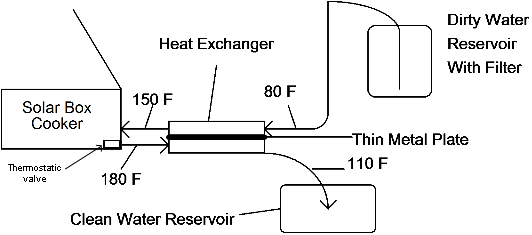Tom Sponheim (talk | contribs) No edit summary |
Tom Sponheim (talk | contribs) (added category) |
||
| Line 9: | Line 9: | ||
A simple device which accomplishes this preheating is a counter-current heat exchanger. The hot water flows on one side of a metal plate, while on the other side of the plate cooler fluid flows in the opposite direction. The energy from the hot water is transferred to the cold water, thus preheating the incoming contaminated water by lowering the temperature of the outgoing pasteurized water. There are many ways of building a counter-current heat exchanger. In the initial trials, for an increase in cost of about 15% the heat exchanger provides about a 400% increase in water output. |
A simple device which accomplishes this preheating is a counter-current heat exchanger. The hot water flows on one side of a metal plate, while on the other side of the plate cooler fluid flows in the opposite direction. The energy from the hot water is transferred to the cold water, thus preheating the incoming contaminated water by lowering the temperature of the outgoing pasteurized water. There are many ways of building a counter-current heat exchanger. In the initial trials, for an increase in cost of about 15% the heat exchanger provides about a 400% increase in water output. |
||
| + | |||
| + | [[Category:Solar cooker designs]] |
||
Revision as of 18:54, 7 April 2007
Another way to pasteurize water is a flow-through device. Water flows through a solar collector, one end of which is connected to a thermostatic valve (such as one taken from an automobile radiator system) and the other to a storage tank for the untreated water supply. This storage tank also contains a sand/gravel/charcoal filter that does the preliminary filtering. The thermostatic valve opens at the correct temperature, allowing the pasteurized water to drain out of the tubing and into a second storage vessel for treated water. As the treated water drains from the solar box cooker, contaminated water from the storage tank automatically refills the tubing. Once this cool water reaches the valve the valve shuts and the pasteurization process begins anew.
This flow-through device has several advantages over the simpler batch processes. First, potable water becomes available throughout the day as new increments of treated water are added to the clean storage vessel. Second, this type of unit can adapt to variable solar conditions which takes the guesswork out of filling the jugs in a batch process. This is also a totally automatic process, freeing time for other chores and decreasing the likelihood of an accident occurring when transferring water in and out of a batch unit.
Dramatic improvements can be achieved by recycling the heat in the outgoing pasteurized water. Once the water has been pasteurized and released the energy in this water can be used to preheat the incoming water.
A simple device which accomplishes this preheating is a counter-current heat exchanger. The hot water flows on one side of a metal plate, while on the other side of the plate cooler fluid flows in the opposite direction. The energy from the hot water is transferred to the cold water, thus preheating the incoming contaminated water by lowering the temperature of the outgoing pasteurized water. There are many ways of building a counter-current heat exchanger. In the initial trials, for an increase in cost of about 15% the heat exchanger provides about a 400% increase in water output.

